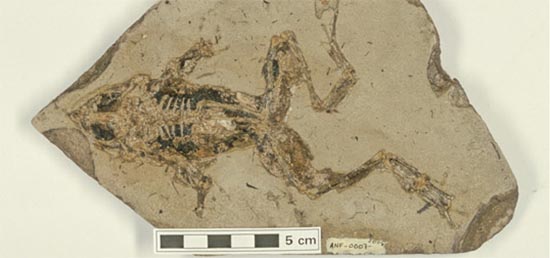

The origins and evolutionary relationships between the three main groups of amphibians (gymnophionans, urodeles and anurans) is a matter of debate. A 2005 molecular phylogeny, based on rDNA analysis, suggested that the first divergence between these three groups took place soon after they had branched from the lobe-finned fish in the Devonian (around 360 million years ago), and before the breakup of the supercontinent Pangaea. The briefness of this period, and the speed at which radiation took place, may help to account for the relative scarcity of amphibian fossils that appear to be closely related to lissamphibians. However, more recent studies have generally found more recent (Late Carboniferous to Permian) age for the basalmost divergence among lissamphibians.
The first known fossil salamanders are Kokartus honorarius from the Middle Jurassic of Kyrgyzstan and two species of the apparently neotenic, aquatic Marmorerpeton from England of a similar date. They looked superficially like robust modern salamanders but lacked a number of anatomical features that developed later. Karaurus sharovi from the Upper Jurassic of Kazakhstan resembled modern mole salamanders in morphology and probably had a similar burrowing lifestyle.
The Cryptobranchoidea (primitive salamanders) and the Salamandroidea, also known as Diadectosalamandroidei, (advanced salamanders) are believed to be sister groups. Both seem to have appeared before the end of the Jurassic, the former being exemplified by Chunerpeton tianyiensis, Pangerpeton sinensis, Jeholotriton paradoxus, Regalerpeton weichangensis, Liaoxitriton daohugouensis and Iridotriton hechti, and the latter by Beiyanerpeton jianpingensis. By the Upper Cretaceous, most or all of the living salamander families had probably appeared. All known fossil salamanders and all extinct species fall under the order Caudata, while sometimes the extant species are grouped together as the Urodela. There are about 655 extant species of salamander.
Triassurus sixtelae fossil found in Kyrgyzstan is the oldest salamander ever found PhysOrg - May 12, 2020
The origin of amphibians is still mostly a mystery to scientists due to a variety of factors - their small size chief among them. It is still not known when they branched off from other tetrapods. In this new effort, the researchers have taken another step closer to finding out - their find, an ancient salamander species called Triassurus sixtelae, was from approximately 230 million years ago (during the Triassic) - the find is approximately 90 million years older than any other salamander fossil. The fossil was excavated during a dig at the Madygen Formation in Kyrgyzstan - several years prior, an incomplete amphibian larva fossil had been found there. Then six years ago, the full (five-centimeter-long) skeletal fossil was found. It has been under study ever since.
Ancient petrified salamander reveals its last meal PhysOrg - October 3, 2017
Accessing the complete anatomy of an extinct animal, i.e. both its external and internal aspects, has often been the dream of paleontologists. Indeed, in 99% of cases, fossils are only represented by hard parts: bones, shells, etc. Fossils preserving soft tissues exist, but they are extremely rare. However, their significance for science is enormous. What did the animal look like? What did they eat? How did they live? Most of these questions can be answered by exceptionally preserved fossils.
New Species of Human-Sized Salamander Found in Portugal NBC - March 24, 2015
Paleontologists have unearthed fossils of an enormous salamander-like creature that lived between 220 and 230 million years ago in the tropical regions of the supercontinent Pangaea. The bones of Metoposaurus algarvensis were discovered in (and named after) the Algarve region of Portugal. The remains suggest the creature was more than six feet long and may have weighed over 200 pounds. It likely had a broad, round head and thin legs that would barely have carried its weight when out of water.
'Monster salamanders' found in fossilized mass grave BBC - March 24, 2015
Scientists have discovered a new species of massive, toothy amphibian dating from 220 million years ago. Hundreds of the creatures probably died when a lake dried up, leaving a huge jumble of bones which is now being excavated in southern Portugal. Although related to modern salamanders, the two-metre beast probably lived more like a crocodile, snapping up fish and scrapping with rivals on the shore.
Giant Salamanders Strolled Onto Land Using Long Limbs Live Science - October 2, 2012
Modern giant salamanders live only in water, but their earliest, largest known ancestor, which had a burly head and lengthy limbs to boot, may have ventured onto land, researchers say. Giant salamanders can grow up to 6 feet (2 meters) long and live up to 100 years. To learn more about the history of these Goliaths, which nowadays dwell in East Asia and North America, scientists analyzed the oldest known fossils of these creatures, 56-million-year-old specimens belonging to the extinct species Aviturus exsecratus from what is now the northwestern Gobi Desert in southern Mongolia.
Ancient muscle tissue extracted from 18 million year old salamander fossil PhysOrg - November 5, 2009
Scientists have extracted organically preserved muscle tissue from an 18 million years old salamander fossil. The discovery by researchers from University College Dublin, the UK and Spain, reported in the Proceedings of the Royal Society B shows that soft tissue can be preserved under a broader set of fossil conditions than previously known. The scientists claim that their discovery is unequivocal evidence that high-fidelity organic preservation of extremely decay prone soft tissues is more common in the fossil record - the only physical record of the history of life on earth.
Earliest salamanders discovered BBC - March 28, 2003, 2012
Scientists have discovered the earliest examples of salamanders - some specimens up to 165 million years old - in fossil beds in Mongolia and China. Scientists say they have found literally thousands of the animals preserved in volcanic ash. The researchers describe one juvenile in particular that reveals the amphibian's eye, folds in its tail and a stomach bulging with clam shrimps.
ANCIENT AND LOST CIVILIZATIONS